Research
Our research group focuses on condensed matter theory, studying the electronic properties of novel materials.
Current group interests include high temperature superconductivity, strongly correlated electrons, liquid crystalline phases of electrons, and soft electronic matter.
Spatial Complexity in Strongly Correlated Electronic Systems
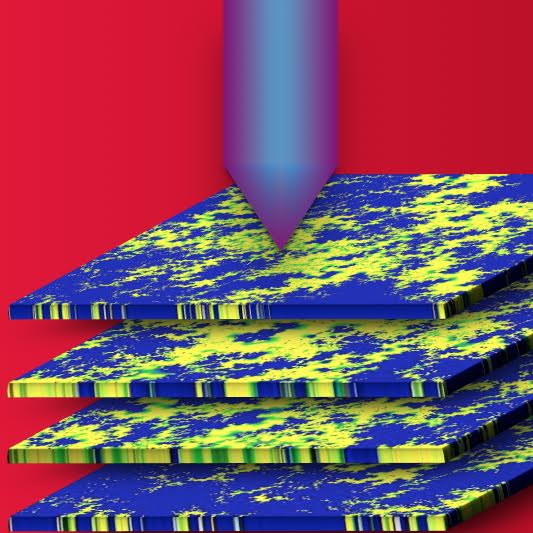 Inside the metals, semiconductors, and magnets of our everyday
experience, electrons are uniformly distributed throughout the
material. By contrast, electrons often form clumpy patterns inside of
strongly correlated electronic systems (SCES) such as colossal
magnetoresistance materials and high temperature superconductors. In
copper-oxide based high temperature superconductors, scanning
tunneling microscopy (STM) has detected an electron nematic on the
surface of the material, in which the electrons form nanoscale
structures which break the rotational symmetry of the host crystal.
These structures may hold the key to unlocking the mystery of high
temperature superconductivity in these materials, but only if the
nematic also exists throughout the entire bulk of the material.
Inside the metals, semiconductors, and magnets of our everyday
experience, electrons are uniformly distributed throughout the
material. By contrast, electrons often form clumpy patterns inside of
strongly correlated electronic systems (SCES) such as colossal
magnetoresistance materials and high temperature superconductors. In
copper-oxide based high temperature superconductors, scanning
tunneling microscopy (STM) has detected an electron nematic on the
surface of the material, in which the electrons form nanoscale
structures which break the rotational symmetry of the host crystal.
These structures may hold the key to unlocking the mystery of high
temperature superconductivity in these materials, but only if the
nematic also exists throughout the entire bulk of the material.
Using new methods we have developed for decoding these surface
structures, we find that the nematic indeed persists throughout the
bulk of the material. We furthermore find that the intricate pattern
formation is set by a delicate balance between disorder,
interactions, and material anisotropy, leading to a fractal nature of
the cluster pattern. The methods we have developed can be extended to
many other surface probes and materials, enabling surface probes to
determine whether surface structures are confined only to the surface,
or whether they extend throughout the material.
E. W. Carlson and K. A.
Dahmen, "Using Disorder to Detect Locally Ordered Electron Nematics via Hysteresis,"
Nature Communications 2, 379 (2011).
S. Liu, B. Phillabaum, E. W. Carlson, K. A. Dahmen, N. S. Vidhyadhiraja, M. M. Qazilbash, and D. N. Basov,
"Random Field Driven Spatial Complexity at the Mott Transition in VO2,"
Phys. Rev. Lett., 116, 036401 (2016).
High Temperature Superconductivity
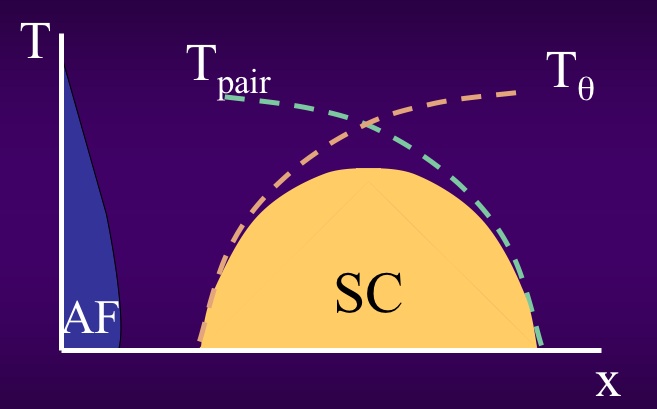 Superconductivity requires that electrons pair, and also become phase coherent.
The transition temperature to superconductivity must be below both the energy scale of pairing,
and the energy scale of phase coherence. The "catch 22" of raising the transition temperature is that
raising one of these energy scales often results in the decrease of the other, and it is
difficult to parametrically raise the transition temperature. This is seen empirically in
the cuprate superconductors, where on the underdoped side, pairing (as measured by, e.g.
the single particle tunneling gap) is strong but the
phase stiffness energy scale (as measured by London penetration depth measurements) is weak.
On the overdoped side, the situation is reversed, and as the phase stiffness energy scale
rises, the paring scale is depressed.
Superconductivity requires that electrons pair, and also become phase coherent.
The transition temperature to superconductivity must be below both the energy scale of pairing,
and the energy scale of phase coherence. The "catch 22" of raising the transition temperature is that
raising one of these energy scales often results in the decrease of the other, and it is
difficult to parametrically raise the transition temperature. This is seen empirically in
the cuprate superconductors, where on the underdoped side, pairing (as measured by, e.g.
the single particle tunneling gap) is strong but the
phase stiffness energy scale (as measured by London penetration depth measurements) is weak.
On the overdoped side, the situation is reversed, and as the phase stiffness energy scale
rises, the paring scale is depressed.
E. W. Carlson, V. J. Emery, S. A. Kivelson, and D. Orgad, "Concepts in High Temperature Superconductivity," in The Physics of Conventional and Unconventional Superconductors, Vol. 2, ed. K.H. Bennemann and J.B. Ketterson (Springer-Verlag 2004)
Electronic Ising Nematic
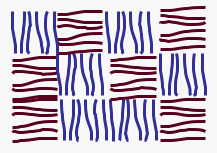 Stripes within the copper-oxygen plane tend to lock to favorable lattice directions.
For certain ranges of dopings, stripes lock to the Cu-O bond direction. In a four-fold symmetric crystal,
stripes can lock either "vertically" or "horizontally" in the copper-oxygen plane, giving
a natural mapping to the Ising model, where, e.g., up spins correspond to vertical stripe patches,
and down spins correspond to horizontal ones.
Disorder in the form of dopant atoms between planes favors one or the other direction locally,
and acts as a random field on the Ising pseudospin.
We are studying the consequences of this mapping for macroscopic nonequilibrium properties
such as anisotropic transport, and also for local probes such as scanning tunneling microscopy.
Stripes within the copper-oxygen plane tend to lock to favorable lattice directions.
For certain ranges of dopings, stripes lock to the Cu-O bond direction. In a four-fold symmetric crystal,
stripes can lock either "vertically" or "horizontally" in the copper-oxygen plane, giving
a natural mapping to the Ising model, where, e.g., up spins correspond to vertical stripe patches,
and down spins correspond to horizontal ones.
Disorder in the form of dopant atoms between planes favors one or the other direction locally,
and acts as a random field on the Ising pseudospin.
We are studying the consequences of this mapping for macroscopic nonequilibrium properties
such as anisotropic transport, and also for local probes such as scanning tunneling microscopy.
E. W. Carlson, K. A. Dahmen, E. Fradkin, S. A.
Kivelson, "Hysteresis and Noise from Electronic Nematicity in High
Temperature Superconductors,"
Phys. Rev. Lett, 96, 097003 (2006).
Vortex Smectic-A
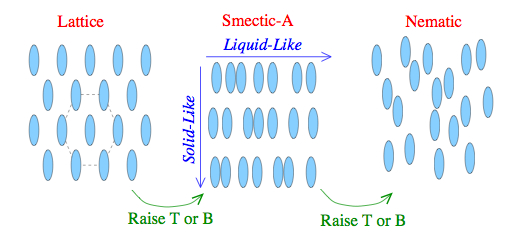 In anisotropic Type II superconductors, vortices have elongated cross sections,
and anisotropic interactions. Anisotropic, repulsive objects generically give rise to liquid crystal
phases. We predicted a new type of vortex phase in anisotropic superconductors, whereby the
anisotropic Abrikosov lattice melts first into a smectic as temperature is raised, and then into the high
temperature disordered phase. The vortex smectic forms an intermediate broken symmetry phase,
where the vortices are liquid-like in one direction perpendicular to the
external magnetic field, but lattice-like in the other. Because vortices melt first along the
direction of short lattice constant, the intermediate phase has the symmetry of a smectic-A.
In anisotropic Type II superconductors, vortices have elongated cross sections,
and anisotropic interactions. Anisotropic, repulsive objects generically give rise to liquid crystal
phases. We predicted a new type of vortex phase in anisotropic superconductors, whereby the
anisotropic Abrikosov lattice melts first into a smectic as temperature is raised, and then into the high
temperature disordered phase. The vortex smectic forms an intermediate broken symmetry phase,
where the vortices are liquid-like in one direction perpendicular to the
external magnetic field, but lattice-like in the other. Because vortices melt first along the
direction of short lattice constant, the intermediate phase has the symmetry of a smectic-A.
E. W. Carlson, A. H. Castro Neto, and D. K. Campbell, "Vortex Liquid Crystals in Anisotropic Type II Superconductors," Phys. Rev. Lett. 90, 087001 (2003)
Spin Waves in Striped Phases
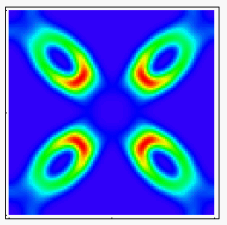 Certain nickelate materials and some cuprate materials show evidence of stripe phases,
whereby holes doped into an antiferromagnet congregate in lines called charge stripes.
Each charge stripe introduces a line defect in the form of a &pi phase shift
in the parent antiferromagnetic texture, leading to the formation of spin stripes as well.
The elementary excitations of fully ordered spin stripes are spin waves, observable
as finite energy excitations in neutron scattering experiments. We have studied both site-centered
stripes, where the charged domain walls like on Ni or Cu sites, and bond-centered
stripes, where the charge lines lie between Ni or Cu sites, and developed a litmus test for ruling out
site-centered stripes from low energy neutron data.
Certain nickelate materials and some cuprate materials show evidence of stripe phases,
whereby holes doped into an antiferromagnet congregate in lines called charge stripes.
Each charge stripe introduces a line defect in the form of a &pi phase shift
in the parent antiferromagnetic texture, leading to the formation of spin stripes as well.
The elementary excitations of fully ordered spin stripes are spin waves, observable
as finite energy excitations in neutron scattering experiments. We have studied both site-centered
stripes, where the charged domain walls like on Ni or Cu sites, and bond-centered
stripes, where the charge lines lie between Ni or Cu sites, and developed a litmus test for ruling out
site-centered stripes from low energy neutron data.
E. W. Carlson, D.-X. Yao, and D. K. Campbell, "Spin Waves in Striped Phases," Phys. Rev. B, 70, 064505 (2004).
|

